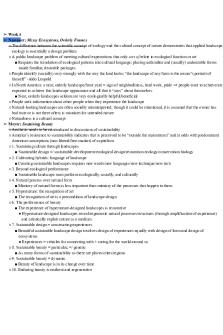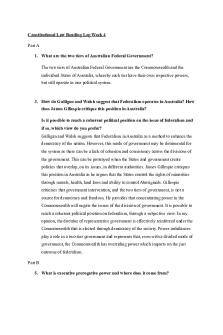PSYC2018 Week 4 reading Cortical Organisation PDF

| Title | PSYC2018 Week 4 reading Cortical Organisation |
|---|---|
| Author | Lauren Wakeling |
| Course | Perception |
| Institution | University of Southampton |
| Pages | 2 |
| File Size | 40 KB |
| File Type | |
| Total Downloads | 68 |
| Total Views | 142 |
Summary
Week 4 reading summary...
Description
Electronic Map V1: - Spatial organisation: the way stimuli at specific locations in the enironment are represented by activity at specific locations in nervous system - Points on the retinal image cause activity on the cortex, locations on cortex correspond to locations on retina - Retinotopic map: electronic map of retina on cortex, means that 2 point that are close together on an object and the retina will activate neurons object and the retina will activate neurons that are close together in the brain - Map is distorted, more space being allotted to locations near fovea than periphery cortical magnification Methods: - PET: radioactive tracer shows direction of blood flow - fMRI: based on measurement of blood flow can indicate areas of high brain activity because hemoglobin molecules lose some oxygen Cortex Columns: - Hubel and Wiesel: - Carried out experiments where they recorded neurons they encountered as they lowered electrodes into the cortex - Striate cortex is organised into location columns that are perpendicular to the surface of the cortex - So all neurons within a location column have their receptive fields at same location on retina - The cortex is also organised into orientation columns with each column containing cells that respond best to a particular orientation - 1mm dimension for location columns means one location column is large enough to contain orientation columns that cover all possible orientations - Hypercolumn: a location column with all of its orientation columns receives information about all possible orientations that fall within a small area of the retina Feature Detector Response: - Tree example: - Circles representing area served by a location column, each location column contains complete set of orientation columns - Vertical tree trunk will activate the 90 degree orientation columns - Continuous tree trunk represented by firing of neurons in a number of separated columns - Columns over entire visual field work together - tiling Streams For What/Where Info: - Ungerleider and Mishkin (1982): - Lesioning - Monkeys 2 tasks - object discrimination problem and landmark discrimination problem - Part of temporal lobe removed in some monkeys, object discrimination very difficult for
-
these monkeys Indicates the pathway responsible for determining an objects identity is the one that goes to temporal lobes Other monkeys had parietal lobes removed and had difficulty with landmarks Ventral pathway is WHAT Dorsal pathway is WHERE Ventral and dorsal streams can be traced back to retina and LGN Pathways aren’t completely separate Signals flow not only up but backwards Backward flow of info = feedback Patient DF: Performed poorly in static orientation matching task (could not orient card to match slot) but could do well on action (asked to mail through slot and could do it) Suggests one mechanism for judging orientation and another for coordinating vision and action Have demonstrated double dissociation Within pathways: Modules
Face Neurons: - Rolls and Tovee (1995): - Measured response neurons in monkeys inferotemporal cortex - Presented pictures of face and nonface stimuli, many neurons responded to face best - 97% cells face selective - Damage to temporal lobe causes prosopagnosia - difficulty recognising faces of familiar people - Parahippocampal place area (PPA): activated by pictures depicting indoor and outdoor scenes - Extrastriate body area (EBA): activation by pictures of bodies and parts of bodies - Organised spatially and functionally...
Similar Free PDFs

Reading Log - Week 4
- 4 Pages

JS 318 Reading questions week 4
- 5 Pages

ED1 Reading Notes (week 4-14)
- 20 Pages

Organisation
- 3 Pages

Chapter 04 Cortical Organization
- 11 Pages

Week 7 reading questions
- 1 Pages

Reading log - Week 6
- 7 Pages

Week 3 Reading Response
- 3 Pages
Popular Institutions
- Tinajero National High School - Annex
- Politeknik Caltex Riau
- Yokohama City University
- SGT University
- University of Al-Qadisiyah
- Divine Word College of Vigan
- Techniek College Rotterdam
- Universidade de Santiago
- Universiti Teknologi MARA Cawangan Johor Kampus Pasir Gudang
- Poltekkes Kemenkes Yogyakarta
- Baguio City National High School
- Colegio san marcos
- preparatoria uno
- Centro de Bachillerato Tecnológico Industrial y de Servicios No. 107
- Dalian Maritime University
- Quang Trung Secondary School
- Colegio Tecnológico en Informática
- Corporación Regional de Educación Superior
- Grupo CEDVA
- Dar Al Uloom University
- Centro de Estudios Preuniversitarios de la Universidad Nacional de Ingeniería
- 上智大学
- Aakash International School, Nuna Majara
- San Felipe Neri Catholic School
- Kang Chiao International School - New Taipei City
- Misamis Occidental National High School
- Institución Educativa Escuela Normal Juan Ladrilleros
- Kolehiyo ng Pantukan
- Batanes State College
- Instituto Continental
- Sekolah Menengah Kejuruan Kesehatan Kaltara (Tarakan)
- Colegio de La Inmaculada Concepcion - Cebu







